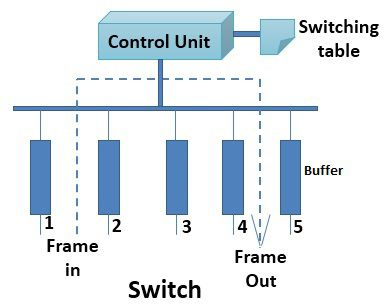A network is formed when two or more devices connect to share data or resources. A large network may need to be subdivided for efficient frame delivery or the traffic management. Bridges or switches are used to connect these subdivided segments of networks. In a long way, the terms bridge and switch are used interchangeably. Bridge and switch both provide the same functionality but the switch does it with greater efficiency.
Bridge
A bridge is a product that connects a local area network (LAN) to another local area network that uses the same protocol (for example, Ethernet or token ring). You can envision a bridge as being a device that decides whether a message from you to someone else is going to the local area network in your building or to someone on the local area network in the building across the street. A bridge examines each message on a LAN, "passing" those known to be within the same LAN, and forwarding those known to be on the other interconnected LAN (or LANs).In bridging networks, computer or node addresses have no specific relationship to location. For this reason, messages are sent out to every address on the network and accepted only by the intended destination node. Bridges learn which addresses are on which network and develop a learning table so that subsequent messages can be forwarded to the right network.

Bridging networks are generally always interconnected local area networks since broadcasting every message to all possible destinations would flood a larger network with unnecessary traffic. For this reason, router networks such as the Internet use a scheme that assigns addresses to nodes so that a message or packet can be forwarded only in one general direction rather than forwarded in all directions.
Switch
A switch is a network device that selects a path or circuit for sending a unit of data to its next destination. A switch may also include the function of the router, a device or program that can determine the route and specifically what adjacent network point the data should be sent to. In general, a switch is a simpler and faster mechanism than a router, which requires knowledge about the network and how to determine the route.
Relative to the layered Open Systems Interconnection (OSI) communication model, a switch is usually associated with layer 2, the Data-Link layer . However, some newer switches also perform the routing functions of layer 3, the Network layer. Layer 3 switches are also sometimes called IP switches.

On larger networks, the trip from one switch point to another in the network is called a hop. The time a switch takes to figure out where to forward a data unit is called its latency. The price paid for having the flexibility that switches provide in a network is this latency. Switches are found at the backbone and gateway levels of a network where one network connects with another and at the subnetwork level where data is being forwarded close to its destination or origin. The former are often known as core switches and the latter as desktop switches.
In the simplest networks, a switch is not required for messages that are sent and received within the network. For example, a local area network may be organized in a token ring or bus arrangement in which each possible destination inspects each message and reads any message with its address.
Key Differences between Bridge and Switch
|
BASIS FOR COMPARISON |
BRIDGE |
SWITCH |
|
Basic |
A bridge can connect fewer LAN. |
A switch can connect more networks compared to the bridge. |
|
Buffer |
Bridges do not have buffers. |
Switch has a buffer for each link connected to it. |
|
Types |
Simple bridge, multiport bridge and transparent bridge. |
Store-and-forward switch and cut-through switch. |
|
Error |
Bridges do not perform error checking. |
Switches perform error checking. |
- Bridges generally connect fewer networks as compared to the switch.
- Switch has a buffer for each link connected to it which is missing in a buffer.
- Switch perform error checking which is not done in a buffer.
- Bridges are classified as a simple bridge, multiport bridge and transparent bridge. On the other hands, a switch can be classified as Store-and-forward switch and cut-through switch.
Conclusion:
Bridges were introduced when the classic Ethernet was used hence they tend to join fewer networks. Switches are the modern bridges, and they tend to join comparatively more networks together and are more efficient than bridges.



















































































































